UTS Taxation Law 77938: Income Tax Assessment of Kate (2017-18)
VerifiedAdded on 2023/06/12
|11
|2251
|162
Report
AI Summary
This report provides a tax determination for Kate for the income year ended 2017-18, focusing on transactions and their tax implications under Australian taxation law. It addresses issues such as permissible deductions under section 8-1 of the ITAA 1997, assessable income under section 6-5 of the ITAA 1997, and capital gains tax considerations for collectibles. The analysis applies relevant legal principles from various sections of the ITAA and FBTAA, as well as case law such as Scott v Commissioner of Taxation and FCT v Stone, to determine the tax treatment of Kate's salary, fringe benefits, prize winnings, appearance fees, collectible sales, rental income, and payments for restricting rights. The report concludes with a calculation of Kate's basic income tax liability, determining the assessable income and applicable deductions based on the findings.
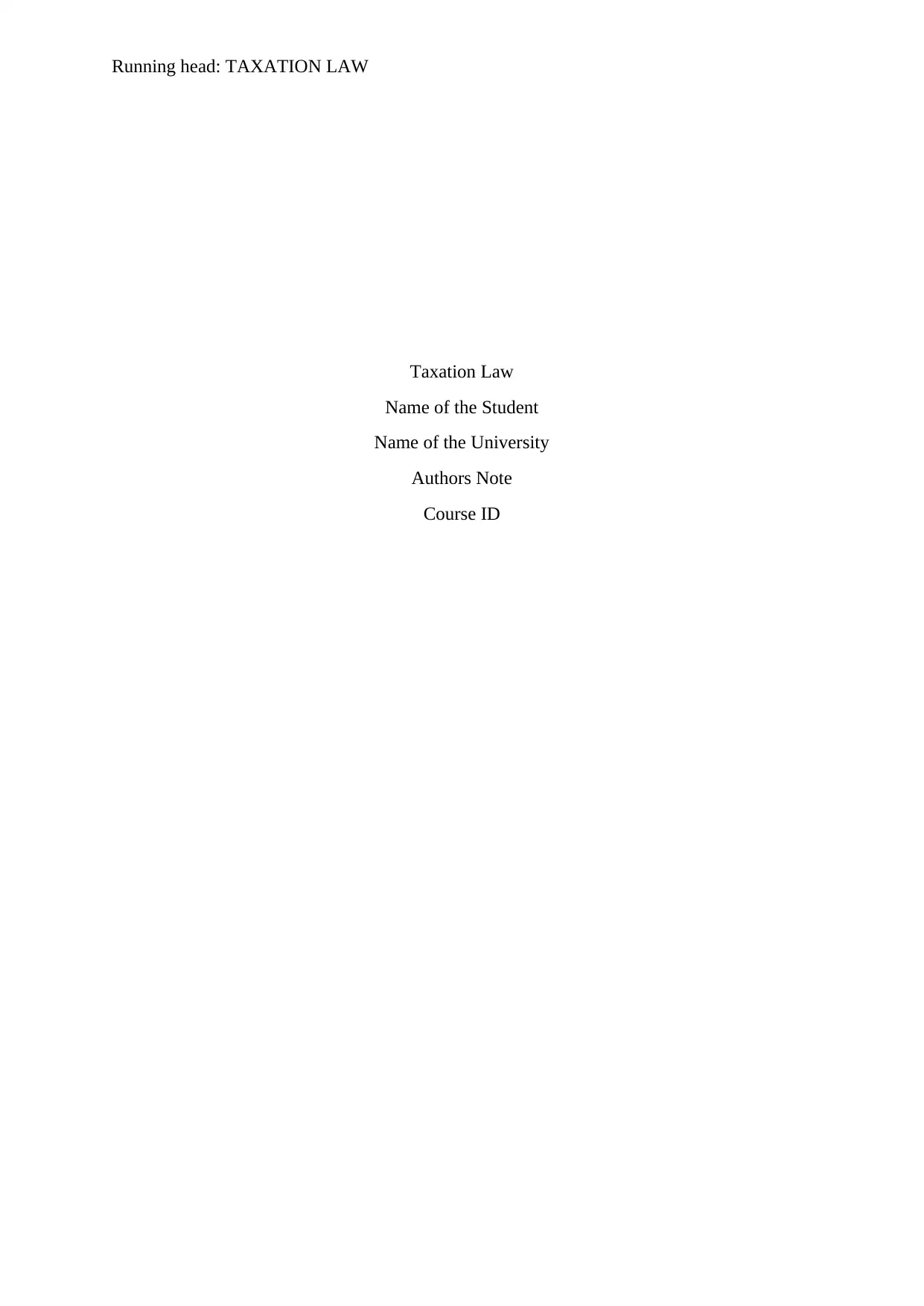
Running head: TAXATION LAW
Taxation Law
Name of the Student
Name of the University
Authors Note
Course ID
Taxation Law
Name of the Student
Name of the University
Authors Note
Course ID
Paraphrase This Document
Need a fresh take? Get an instant paraphrase of this document with our AI Paraphraser
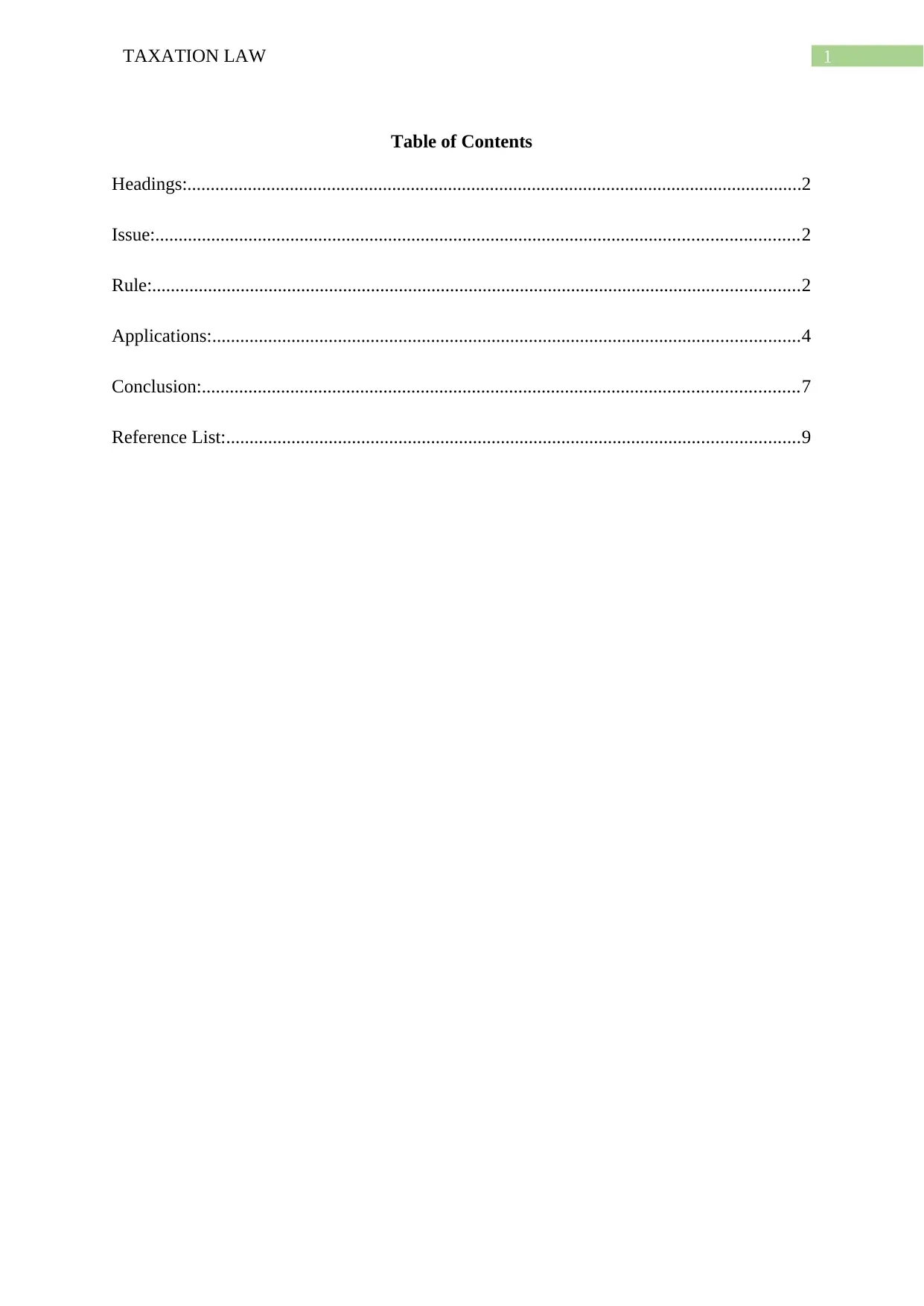
1TAXATION LAW
Table of Contents
Headings:....................................................................................................................................2
Issue:..........................................................................................................................................2
Rule:...........................................................................................................................................2
Applications:..............................................................................................................................4
Conclusion:................................................................................................................................7
Reference List:...........................................................................................................................9
Table of Contents
Headings:....................................................................................................................................2
Issue:..........................................................................................................................................2
Rule:...........................................................................................................................................2
Applications:..............................................................................................................................4
Conclusion:................................................................................................................................7
Reference List:...........................................................................................................................9
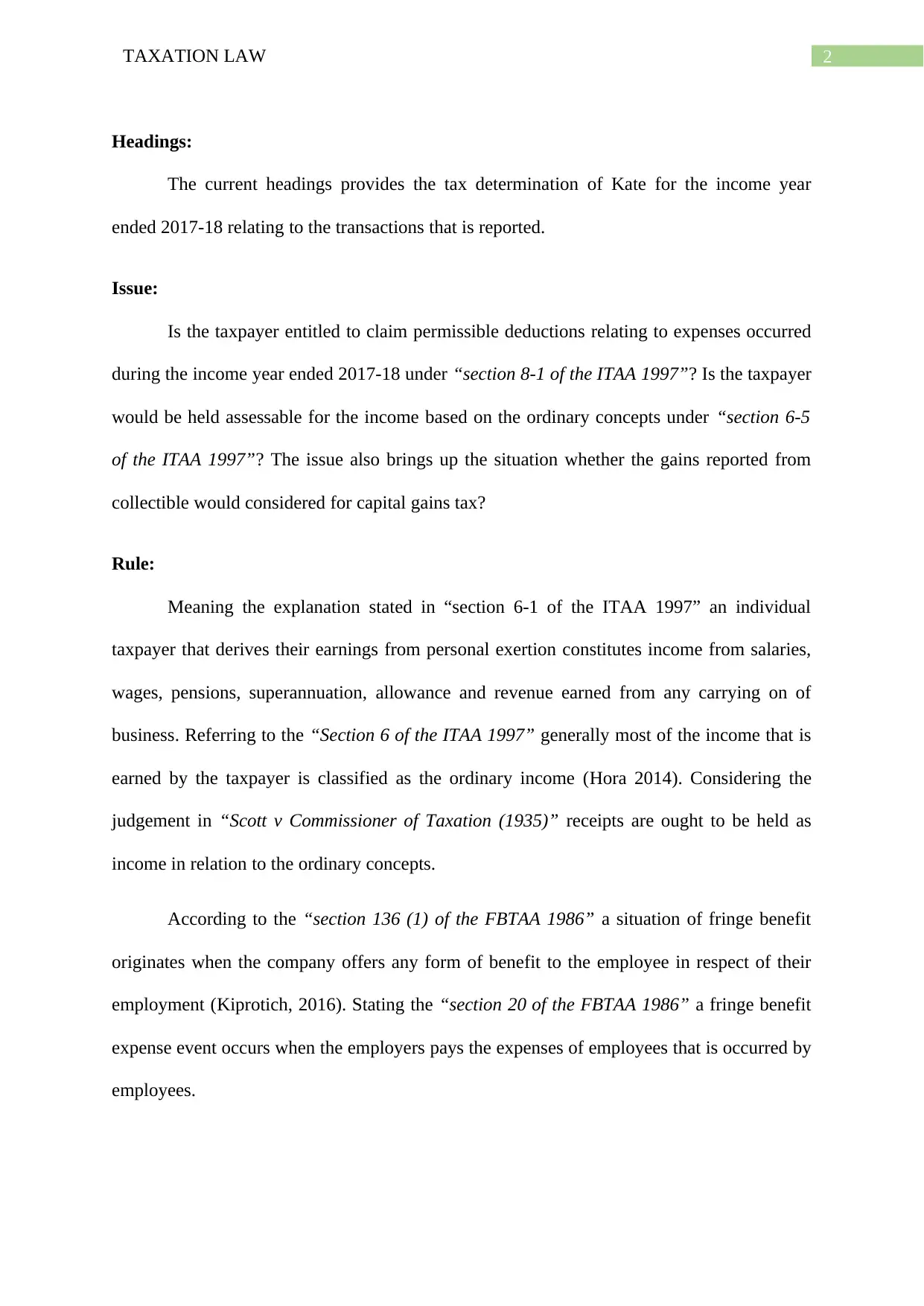
2TAXATION LAW
Headings:
The current headings provides the tax determination of Kate for the income year
ended 2017-18 relating to the transactions that is reported.
Issue:
Is the taxpayer entitled to claim permissible deductions relating to expenses occurred
during the income year ended 2017-18 under “section 8-1 of the ITAA 1997”? Is the taxpayer
would be held assessable for the income based on the ordinary concepts under “section 6-5
of the ITAA 1997”? The issue also brings up the situation whether the gains reported from
collectible would considered for capital gains tax?
Rule:
Meaning the explanation stated in “section 6-1 of the ITAA 1997” an individual
taxpayer that derives their earnings from personal exertion constitutes income from salaries,
wages, pensions, superannuation, allowance and revenue earned from any carrying on of
business. Referring to the “Section 6 of the ITAA 1997” generally most of the income that is
earned by the taxpayer is classified as the ordinary income (Hora 2014). Considering the
judgement in “Scott v Commissioner of Taxation (1935)” receipts are ought to be held as
income in relation to the ordinary concepts.
According to the “section 136 (1) of the FBTAA 1986” a situation of fringe benefit
originates when the company offers any form of benefit to the employee in respect of their
employment (Kiprotich, 2016). Stating the “section 20 of the FBTAA 1986” a fringe benefit
expense event occurs when the employers pays the expenses of employees that is occurred by
employees.
Headings:
The current headings provides the tax determination of Kate for the income year
ended 2017-18 relating to the transactions that is reported.
Issue:
Is the taxpayer entitled to claim permissible deductions relating to expenses occurred
during the income year ended 2017-18 under “section 8-1 of the ITAA 1997”? Is the taxpayer
would be held assessable for the income based on the ordinary concepts under “section 6-5
of the ITAA 1997”? The issue also brings up the situation whether the gains reported from
collectible would considered for capital gains tax?
Rule:
Meaning the explanation stated in “section 6-1 of the ITAA 1997” an individual
taxpayer that derives their earnings from personal exertion constitutes income from salaries,
wages, pensions, superannuation, allowance and revenue earned from any carrying on of
business. Referring to the “Section 6 of the ITAA 1997” generally most of the income that is
earned by the taxpayer is classified as the ordinary income (Hora 2014). Considering the
judgement in “Scott v Commissioner of Taxation (1935)” receipts are ought to be held as
income in relation to the ordinary concepts.
According to the “section 136 (1) of the FBTAA 1986” a situation of fringe benefit
originates when the company offers any form of benefit to the employee in respect of their
employment (Kiprotich, 2016). Stating the “section 20 of the FBTAA 1986” a fringe benefit
expense event occurs when the employers pays the expenses of employees that is occurred by
employees.
⊘ This is a preview!⊘
Do you want full access?
Subscribe today to unlock all pages.

Trusted by 1+ million students worldwide
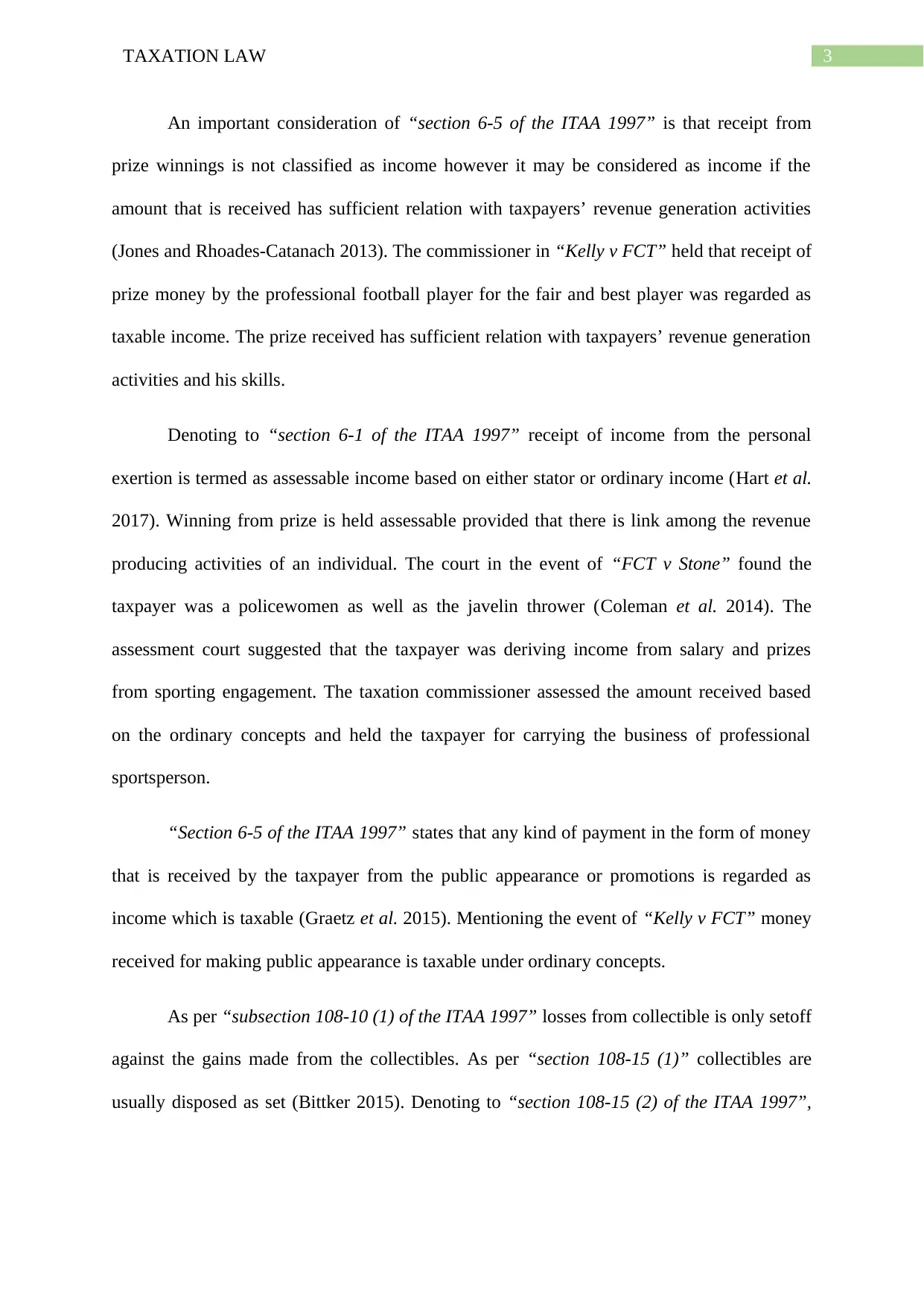
3TAXATION LAW
An important consideration of “section 6-5 of the ITAA 1997” is that receipt from
prize winnings is not classified as income however it may be considered as income if the
amount that is received has sufficient relation with taxpayers’ revenue generation activities
(Jones and Rhoades-Catanach 2013). The commissioner in “Kelly v FCT” held that receipt of
prize money by the professional football player for the fair and best player was regarded as
taxable income. The prize received has sufficient relation with taxpayers’ revenue generation
activities and his skills.
Denoting to “section 6-1 of the ITAA 1997” receipt of income from the personal
exertion is termed as assessable income based on either stator or ordinary income (Hart et al.
2017). Winning from prize is held assessable provided that there is link among the revenue
producing activities of an individual. The court in the event of “FCT v Stone” found the
taxpayer was a policewomen as well as the javelin thrower (Coleman et al. 2014). The
assessment court suggested that the taxpayer was deriving income from salary and prizes
from sporting engagement. The taxation commissioner assessed the amount received based
on the ordinary concepts and held the taxpayer for carrying the business of professional
sportsperson.
“Section 6-5 of the ITAA 1997” states that any kind of payment in the form of money
that is received by the taxpayer from the public appearance or promotions is regarded as
income which is taxable (Graetz et al. 2015). Mentioning the event of “Kelly v FCT” money
received for making public appearance is taxable under ordinary concepts.
As per “subsection 108-10 (1) of the ITAA 1997” losses from collectible is only setoff
against the gains made from the collectibles. As per “section 108-15 (1)” collectibles are
usually disposed as set (Bittker 2015). Denoting to “section 108-15 (2) of the ITAA 1997”,
An important consideration of “section 6-5 of the ITAA 1997” is that receipt from
prize winnings is not classified as income however it may be considered as income if the
amount that is received has sufficient relation with taxpayers’ revenue generation activities
(Jones and Rhoades-Catanach 2013). The commissioner in “Kelly v FCT” held that receipt of
prize money by the professional football player for the fair and best player was regarded as
taxable income. The prize received has sufficient relation with taxpayers’ revenue generation
activities and his skills.
Denoting to “section 6-1 of the ITAA 1997” receipt of income from the personal
exertion is termed as assessable income based on either stator or ordinary income (Hart et al.
2017). Winning from prize is held assessable provided that there is link among the revenue
producing activities of an individual. The court in the event of “FCT v Stone” found the
taxpayer was a policewomen as well as the javelin thrower (Coleman et al. 2014). The
assessment court suggested that the taxpayer was deriving income from salary and prizes
from sporting engagement. The taxation commissioner assessed the amount received based
on the ordinary concepts and held the taxpayer for carrying the business of professional
sportsperson.
“Section 6-5 of the ITAA 1997” states that any kind of payment in the form of money
that is received by the taxpayer from the public appearance or promotions is regarded as
income which is taxable (Graetz et al. 2015). Mentioning the event of “Kelly v FCT” money
received for making public appearance is taxable under ordinary concepts.
As per “subsection 108-10 (1) of the ITAA 1997” losses from collectible is only setoff
against the gains made from the collectibles. As per “section 108-15 (1)” collectibles are
usually disposed as set (Bittker 2015). Denoting to “section 108-15 (2) of the ITAA 1997”,
Paraphrase This Document
Need a fresh take? Get an instant paraphrase of this document with our AI Paraphraser
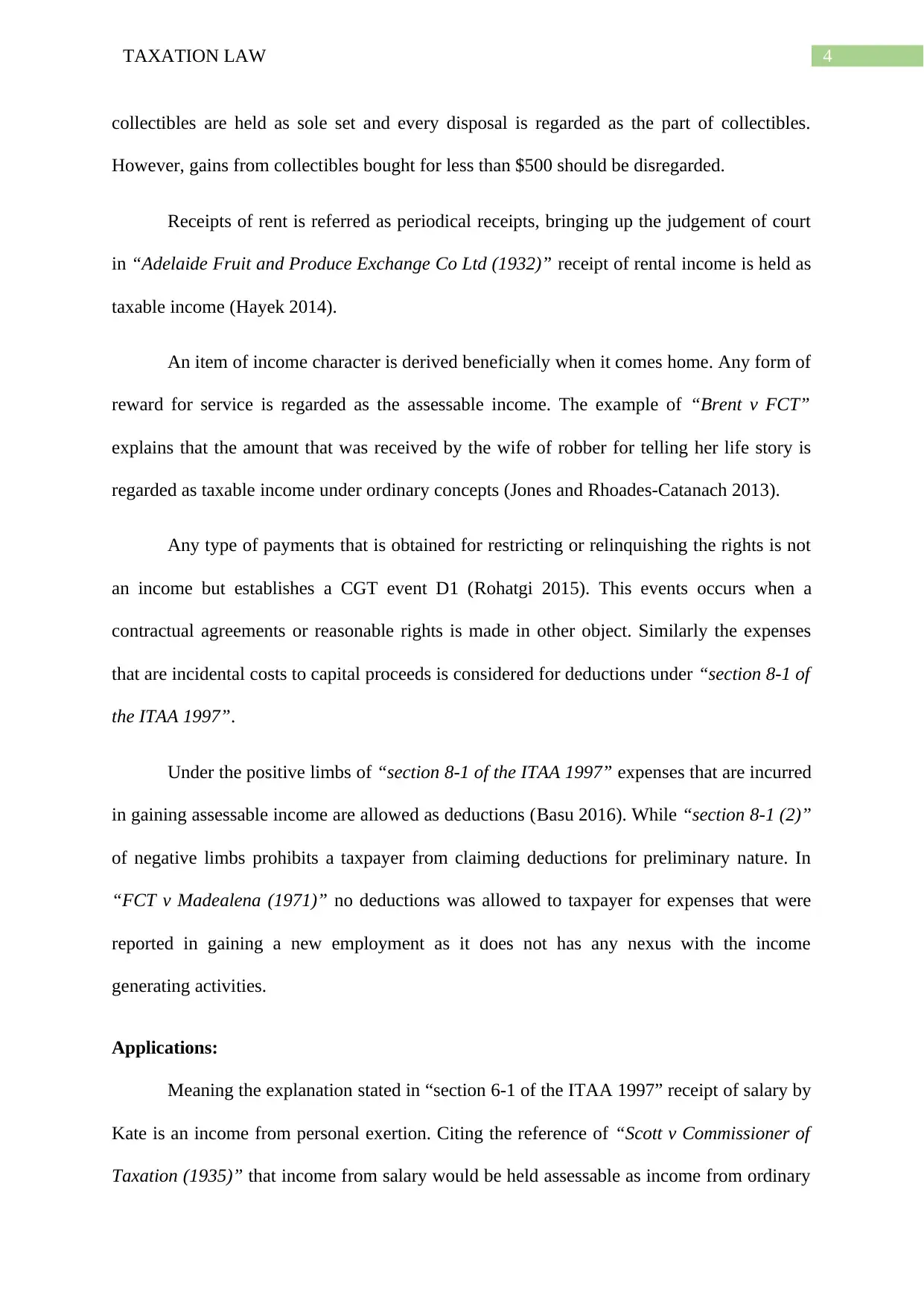
4TAXATION LAW
collectibles are held as sole set and every disposal is regarded as the part of collectibles.
However, gains from collectibles bought for less than $500 should be disregarded.
Receipts of rent is referred as periodical receipts, bringing up the judgement of court
in “Adelaide Fruit and Produce Exchange Co Ltd (1932)” receipt of rental income is held as
taxable income (Hayek 2014).
An item of income character is derived beneficially when it comes home. Any form of
reward for service is regarded as the assessable income. The example of “Brent v FCT”
explains that the amount that was received by the wife of robber for telling her life story is
regarded as taxable income under ordinary concepts (Jones and Rhoades-Catanach 2013).
Any type of payments that is obtained for restricting or relinquishing the rights is not
an income but establishes a CGT event D1 (Rohatgi 2015). This events occurs when a
contractual agreements or reasonable rights is made in other object. Similarly the expenses
that are incidental costs to capital proceeds is considered for deductions under “section 8-1 of
the ITAA 1997”.
Under the positive limbs of “section 8-1 of the ITAA 1997” expenses that are incurred
in gaining assessable income are allowed as deductions (Basu 2016). While “section 8-1 (2)”
of negative limbs prohibits a taxpayer from claiming deductions for preliminary nature. In
“FCT v Madealena (1971)” no deductions was allowed to taxpayer for expenses that were
reported in gaining a new employment as it does not has any nexus with the income
generating activities.
Applications:
Meaning the explanation stated in “section 6-1 of the ITAA 1997” receipt of salary by
Kate is an income from personal exertion. Citing the reference of “Scott v Commissioner of
Taxation (1935)” that income from salary would be held assessable as income from ordinary
collectibles are held as sole set and every disposal is regarded as the part of collectibles.
However, gains from collectibles bought for less than $500 should be disregarded.
Receipts of rent is referred as periodical receipts, bringing up the judgement of court
in “Adelaide Fruit and Produce Exchange Co Ltd (1932)” receipt of rental income is held as
taxable income (Hayek 2014).
An item of income character is derived beneficially when it comes home. Any form of
reward for service is regarded as the assessable income. The example of “Brent v FCT”
explains that the amount that was received by the wife of robber for telling her life story is
regarded as taxable income under ordinary concepts (Jones and Rhoades-Catanach 2013).
Any type of payments that is obtained for restricting or relinquishing the rights is not
an income but establishes a CGT event D1 (Rohatgi 2015). This events occurs when a
contractual agreements or reasonable rights is made in other object. Similarly the expenses
that are incidental costs to capital proceeds is considered for deductions under “section 8-1 of
the ITAA 1997”.
Under the positive limbs of “section 8-1 of the ITAA 1997” expenses that are incurred
in gaining assessable income are allowed as deductions (Basu 2016). While “section 8-1 (2)”
of negative limbs prohibits a taxpayer from claiming deductions for preliminary nature. In
“FCT v Madealena (1971)” no deductions was allowed to taxpayer for expenses that were
reported in gaining a new employment as it does not has any nexus with the income
generating activities.
Applications:
Meaning the explanation stated in “section 6-1 of the ITAA 1997” receipt of salary by
Kate is an income from personal exertion. Citing the reference of “Scott v Commissioner of
Taxation (1935)” that income from salary would be held assessable as income from ordinary
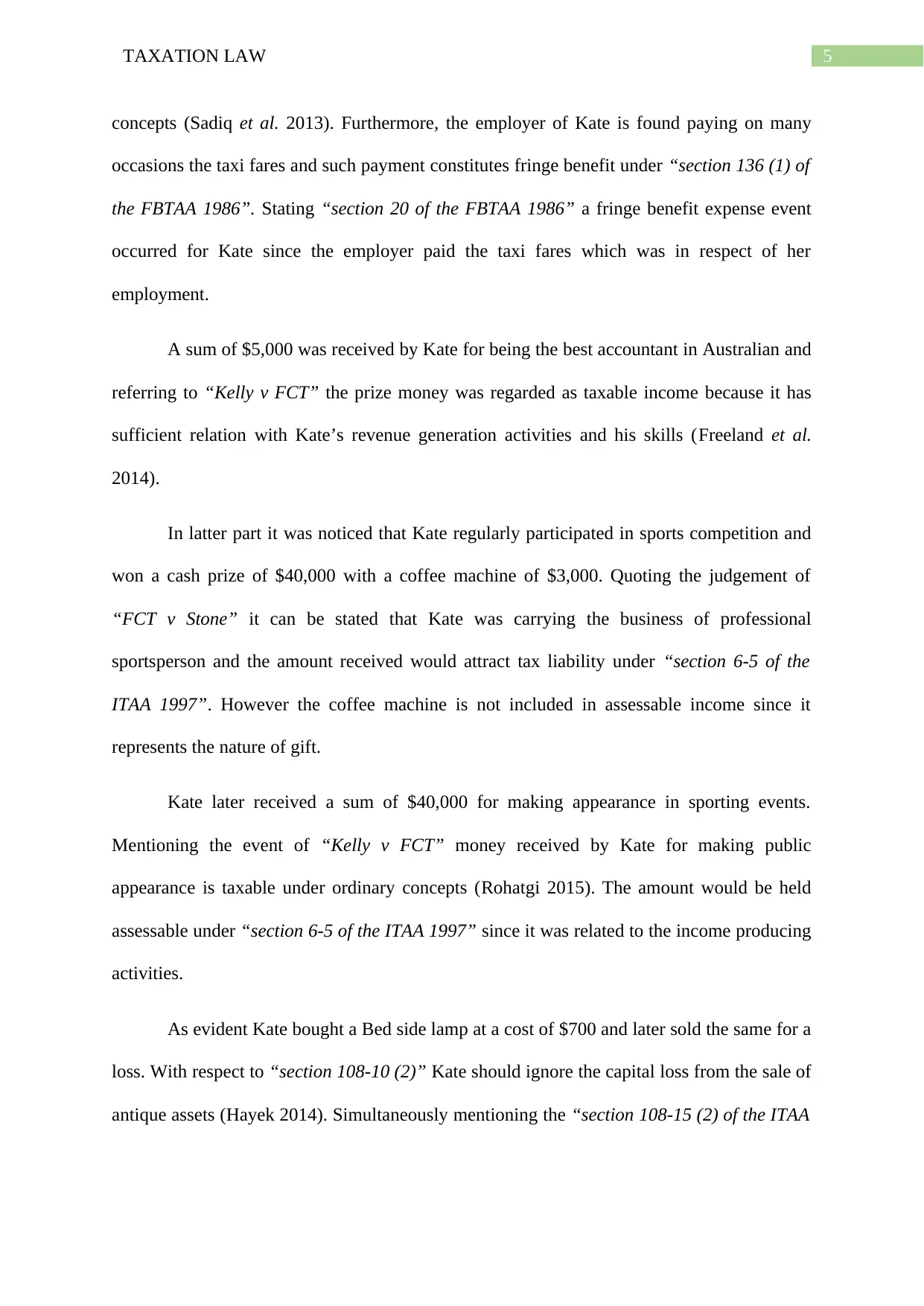
5TAXATION LAW
concepts (Sadiq et al. 2013). Furthermore, the employer of Kate is found paying on many
occasions the taxi fares and such payment constitutes fringe benefit under “section 136 (1) of
the FBTAA 1986”. Stating “section 20 of the FBTAA 1986” a fringe benefit expense event
occurred for Kate since the employer paid the taxi fares which was in respect of her
employment.
A sum of $5,000 was received by Kate for being the best accountant in Australian and
referring to “Kelly v FCT” the prize money was regarded as taxable income because it has
sufficient relation with Kate’s revenue generation activities and his skills (Freeland et al.
2014).
In latter part it was noticed that Kate regularly participated in sports competition and
won a cash prize of $40,000 with a coffee machine of $3,000. Quoting the judgement of
“FCT v Stone” it can be stated that Kate was carrying the business of professional
sportsperson and the amount received would attract tax liability under “section 6-5 of the
ITAA 1997”. However the coffee machine is not included in assessable income since it
represents the nature of gift.
Kate later received a sum of $40,000 for making appearance in sporting events.
Mentioning the event of “Kelly v FCT” money received by Kate for making public
appearance is taxable under ordinary concepts (Rohatgi 2015). The amount would be held
assessable under “section 6-5 of the ITAA 1997” since it was related to the income producing
activities.
As evident Kate bought a Bed side lamp at a cost of $700 and later sold the same for a
loss. With respect to “section 108-10 (2)” Kate should ignore the capital loss from the sale of
antique assets (Hayek 2014). Simultaneously mentioning the “section 108-15 (2) of the ITAA
concepts (Sadiq et al. 2013). Furthermore, the employer of Kate is found paying on many
occasions the taxi fares and such payment constitutes fringe benefit under “section 136 (1) of
the FBTAA 1986”. Stating “section 20 of the FBTAA 1986” a fringe benefit expense event
occurred for Kate since the employer paid the taxi fares which was in respect of her
employment.
A sum of $5,000 was received by Kate for being the best accountant in Australian and
referring to “Kelly v FCT” the prize money was regarded as taxable income because it has
sufficient relation with Kate’s revenue generation activities and his skills (Freeland et al.
2014).
In latter part it was noticed that Kate regularly participated in sports competition and
won a cash prize of $40,000 with a coffee machine of $3,000. Quoting the judgement of
“FCT v Stone” it can be stated that Kate was carrying the business of professional
sportsperson and the amount received would attract tax liability under “section 6-5 of the
ITAA 1997”. However the coffee machine is not included in assessable income since it
represents the nature of gift.
Kate later received a sum of $40,000 for making appearance in sporting events.
Mentioning the event of “Kelly v FCT” money received by Kate for making public
appearance is taxable under ordinary concepts (Rohatgi 2015). The amount would be held
assessable under “section 6-5 of the ITAA 1997” since it was related to the income producing
activities.
As evident Kate bought a Bed side lamp at a cost of $700 and later sold the same for a
loss. With respect to “section 108-10 (2)” Kate should ignore the capital loss from the sale of
antique assets (Hayek 2014). Simultaneously mentioning the “section 108-15 (2) of the ITAA
⊘ This is a preview!⊘
Do you want full access?
Subscribe today to unlock all pages.

Trusted by 1+ million students worldwide
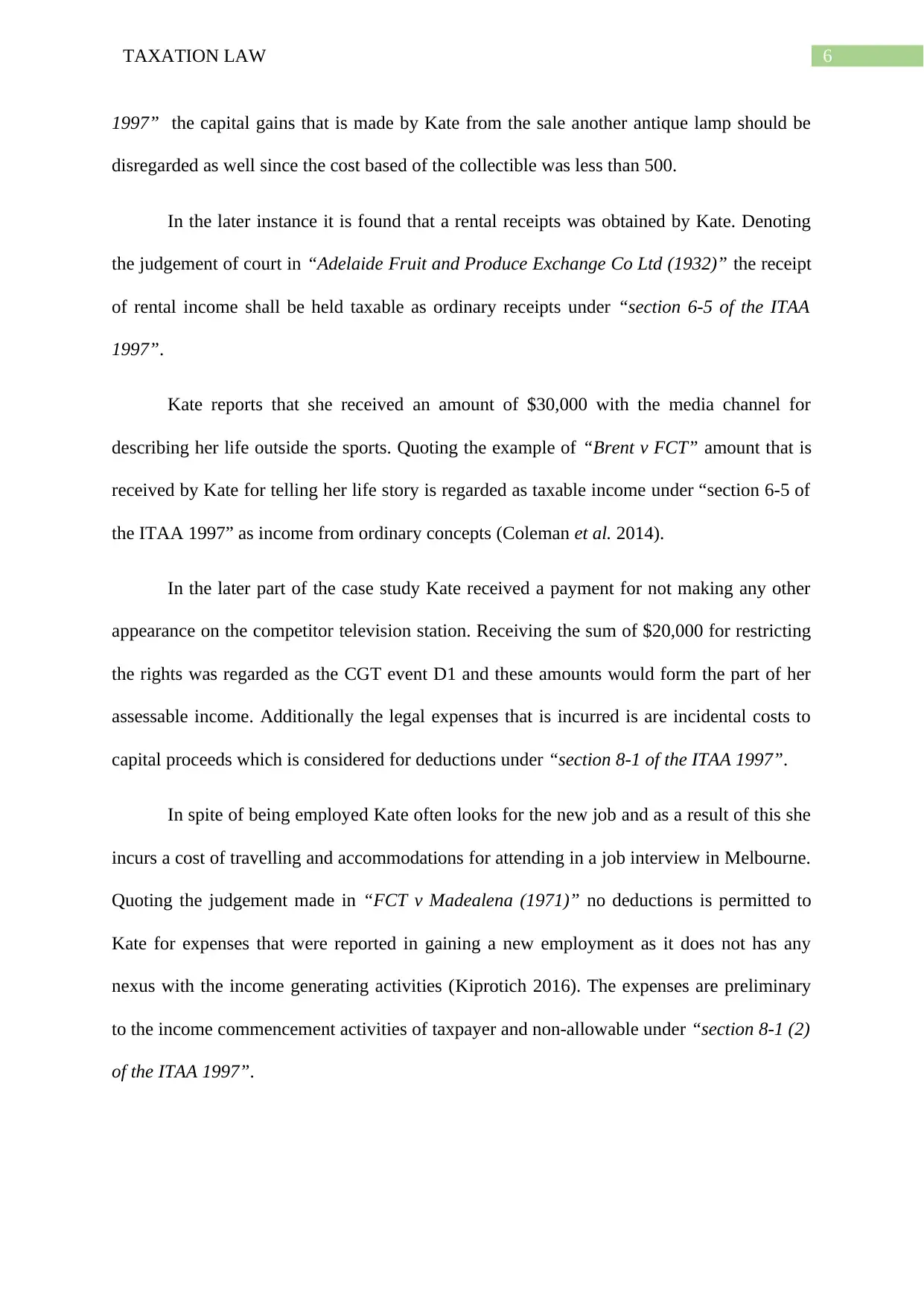
6TAXATION LAW
1997” the capital gains that is made by Kate from the sale another antique lamp should be
disregarded as well since the cost based of the collectible was less than 500.
In the later instance it is found that a rental receipts was obtained by Kate. Denoting
the judgement of court in “Adelaide Fruit and Produce Exchange Co Ltd (1932)” the receipt
of rental income shall be held taxable as ordinary receipts under “section 6-5 of the ITAA
1997”.
Kate reports that she received an amount of $30,000 with the media channel for
describing her life outside the sports. Quoting the example of “Brent v FCT” amount that is
received by Kate for telling her life story is regarded as taxable income under “section 6-5 of
the ITAA 1997” as income from ordinary concepts (Coleman et al. 2014).
In the later part of the case study Kate received a payment for not making any other
appearance on the competitor television station. Receiving the sum of $20,000 for restricting
the rights was regarded as the CGT event D1 and these amounts would form the part of her
assessable income. Additionally the legal expenses that is incurred is are incidental costs to
capital proceeds which is considered for deductions under “section 8-1 of the ITAA 1997”.
In spite of being employed Kate often looks for the new job and as a result of this she
incurs a cost of travelling and accommodations for attending in a job interview in Melbourne.
Quoting the judgement made in “FCT v Madealena (1971)” no deductions is permitted to
Kate for expenses that were reported in gaining a new employment as it does not has any
nexus with the income generating activities (Kiprotich 2016). The expenses are preliminary
to the income commencement activities of taxpayer and non-allowable under “section 8-1 (2)
of the ITAA 1997”.
1997” the capital gains that is made by Kate from the sale another antique lamp should be
disregarded as well since the cost based of the collectible was less than 500.
In the later instance it is found that a rental receipts was obtained by Kate. Denoting
the judgement of court in “Adelaide Fruit and Produce Exchange Co Ltd (1932)” the receipt
of rental income shall be held taxable as ordinary receipts under “section 6-5 of the ITAA
1997”.
Kate reports that she received an amount of $30,000 with the media channel for
describing her life outside the sports. Quoting the example of “Brent v FCT” amount that is
received by Kate for telling her life story is regarded as taxable income under “section 6-5 of
the ITAA 1997” as income from ordinary concepts (Coleman et al. 2014).
In the later part of the case study Kate received a payment for not making any other
appearance on the competitor television station. Receiving the sum of $20,000 for restricting
the rights was regarded as the CGT event D1 and these amounts would form the part of her
assessable income. Additionally the legal expenses that is incurred is are incidental costs to
capital proceeds which is considered for deductions under “section 8-1 of the ITAA 1997”.
In spite of being employed Kate often looks for the new job and as a result of this she
incurs a cost of travelling and accommodations for attending in a job interview in Melbourne.
Quoting the judgement made in “FCT v Madealena (1971)” no deductions is permitted to
Kate for expenses that were reported in gaining a new employment as it does not has any
nexus with the income generating activities (Kiprotich 2016). The expenses are preliminary
to the income commencement activities of taxpayer and non-allowable under “section 8-1 (2)
of the ITAA 1997”.
Paraphrase This Document
Need a fresh take? Get an instant paraphrase of this document with our AI Paraphraser
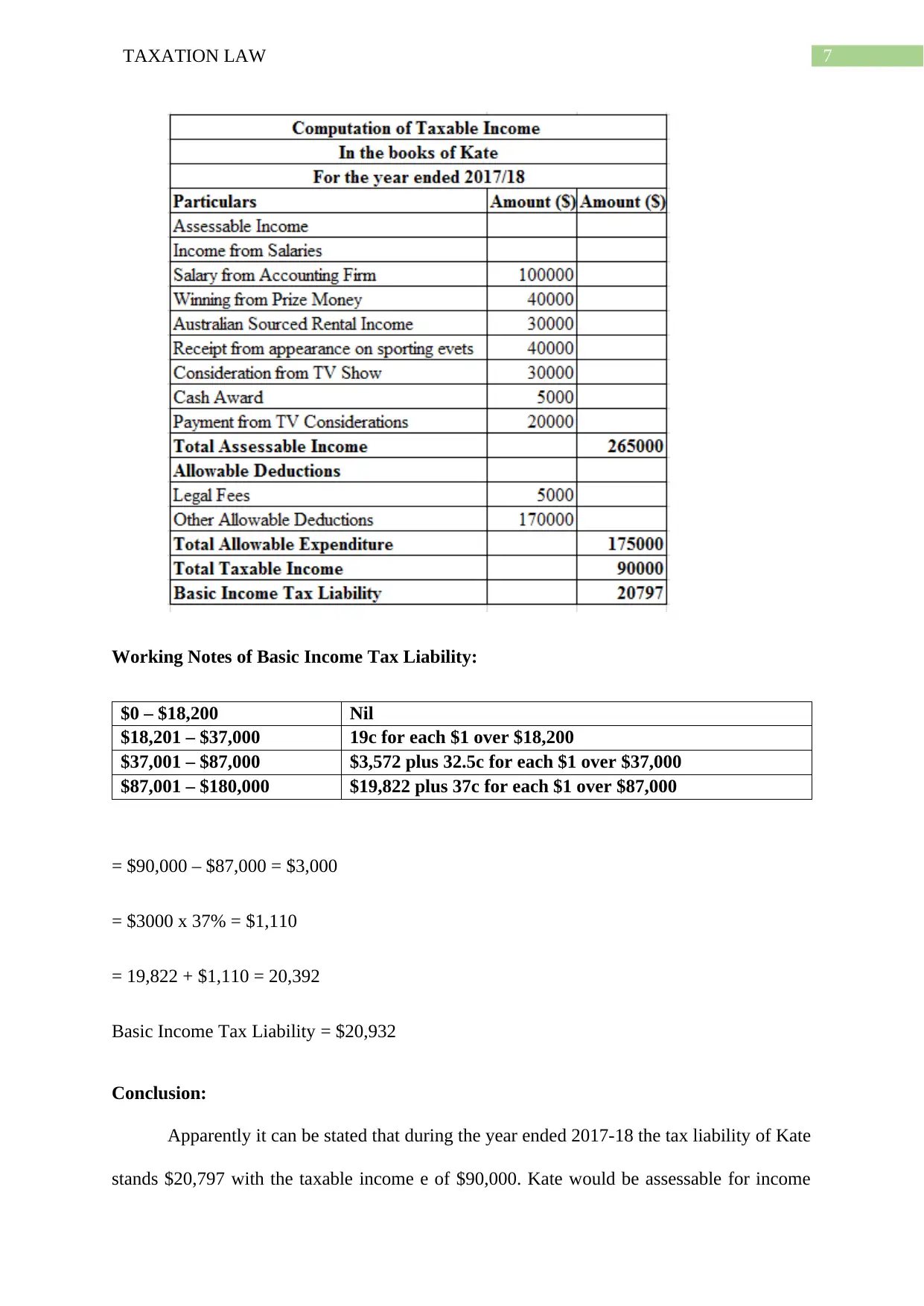
7TAXATION LAW
Working Notes of Basic Income Tax Liability:
$0 – $18,200 Nil
$18,201 – $37,000 19c for each $1 over $18,200
$37,001 – $87,000 $3,572 plus 32.5c for each $1 over $37,000
$87,001 – $180,000 $19,822 plus 37c for each $1 over $87,000
= $90,000 – $87,000 = $3,000
= $3000 x 37% = $1,110
= 19,822 + $1,110 = 20,392
Basic Income Tax Liability = $20,932
Conclusion:
Apparently it can be stated that during the year ended 2017-18 the tax liability of Kate
stands $20,797 with the taxable income e of $90,000. Kate would be assessable for income
Working Notes of Basic Income Tax Liability:
$0 – $18,200 Nil
$18,201 – $37,000 19c for each $1 over $18,200
$37,001 – $87,000 $3,572 plus 32.5c for each $1 over $37,000
$87,001 – $180,000 $19,822 plus 37c for each $1 over $87,000
= $90,000 – $87,000 = $3,000
= $3000 x 37% = $1,110
= 19,822 + $1,110 = 20,392
Basic Income Tax Liability = $20,932
Conclusion:
Apparently it can be stated that during the year ended 2017-18 the tax liability of Kate
stands $20,797 with the taxable income e of $90,000. Kate would be assessable for income
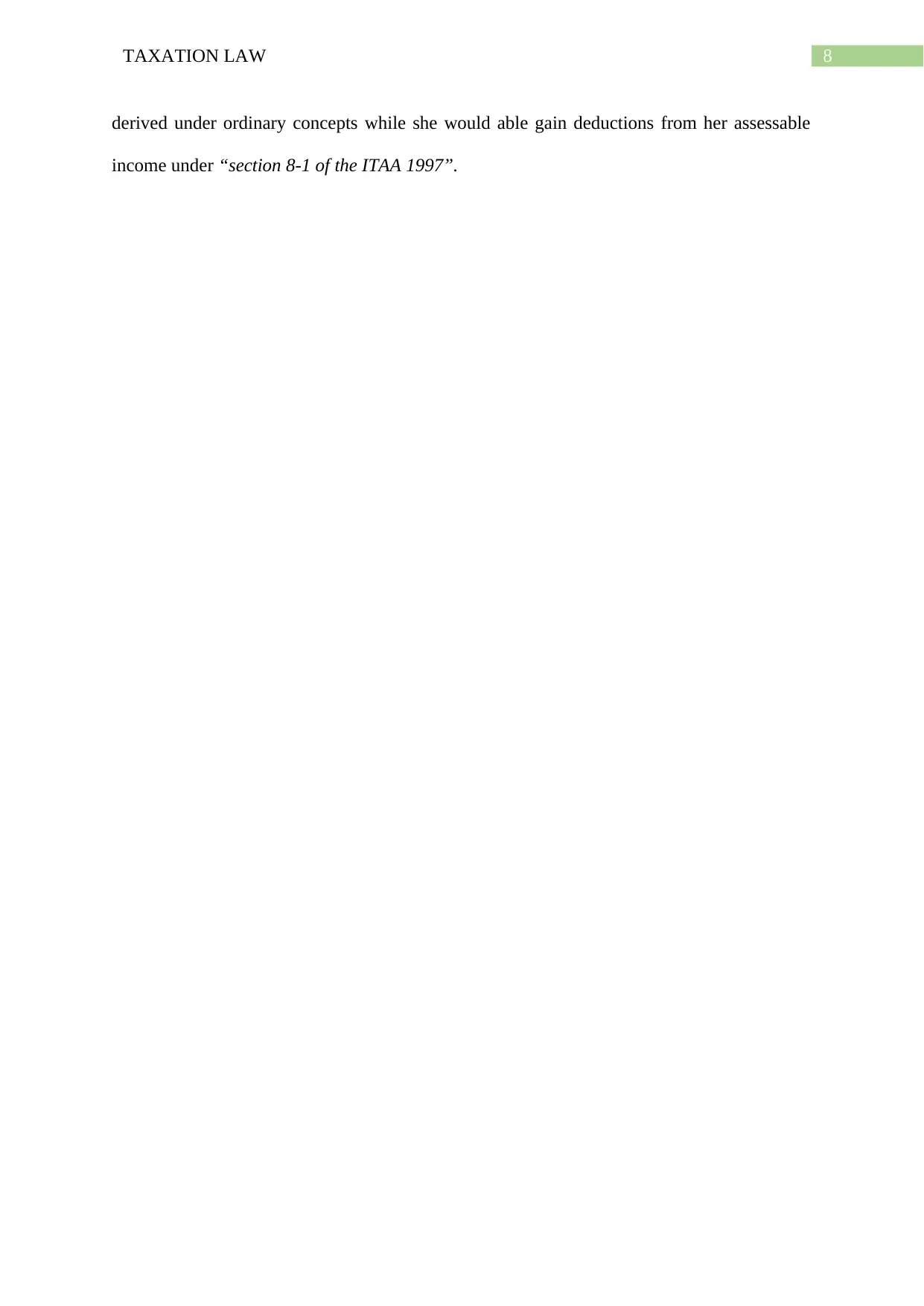
8TAXATION LAW
derived under ordinary concepts while she would able gain deductions from her assessable
income under “section 8-1 of the ITAA 1997”.
derived under ordinary concepts while she would able gain deductions from her assessable
income under “section 8-1 of the ITAA 1997”.
⊘ This is a preview!⊘
Do you want full access?
Subscribe today to unlock all pages.

Trusted by 1+ million students worldwide
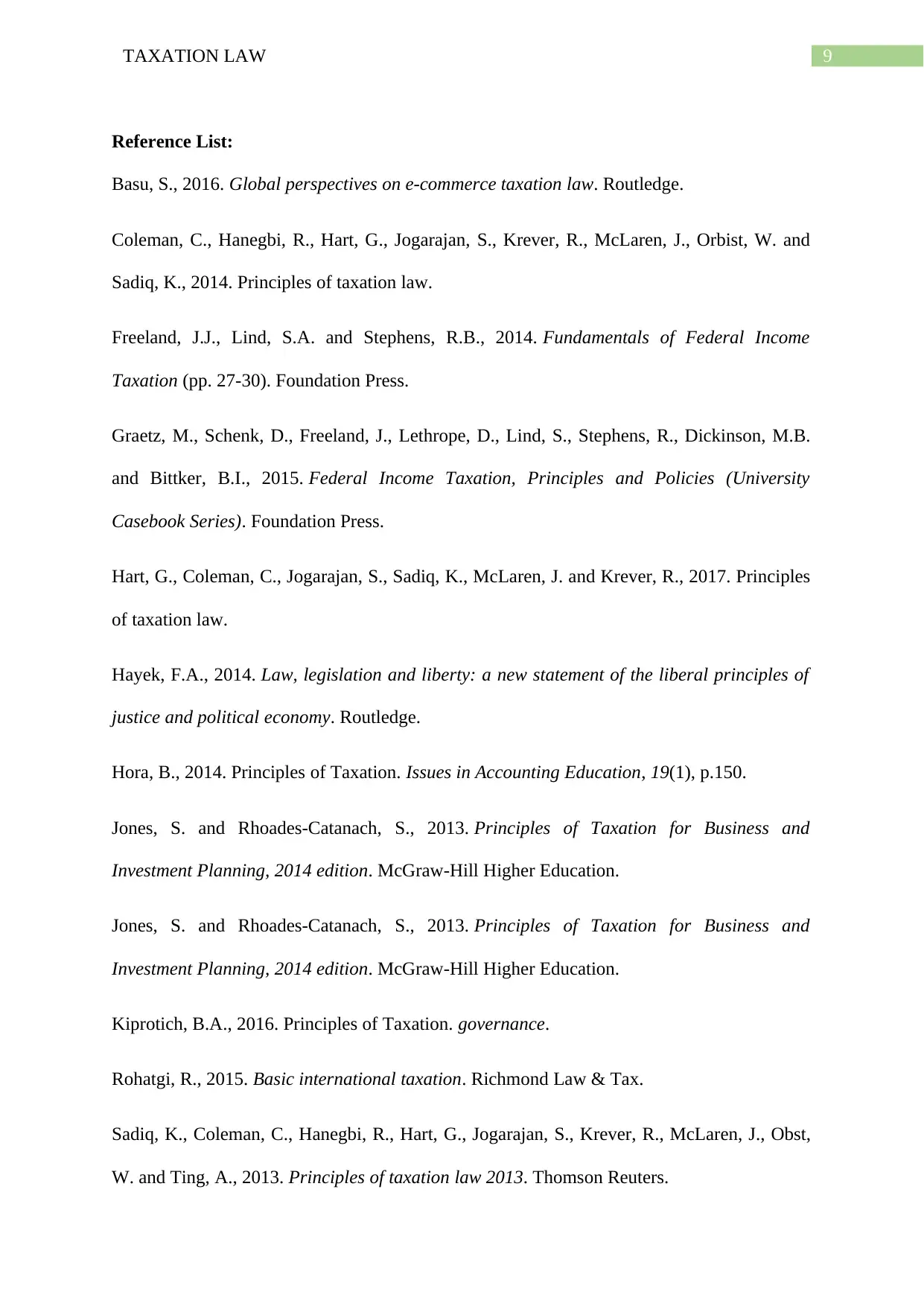
9TAXATION LAW
Reference List:
Basu, S., 2016. Global perspectives on e-commerce taxation law. Routledge.
Coleman, C., Hanegbi, R., Hart, G., Jogarajan, S., Krever, R., McLaren, J., Orbist, W. and
Sadiq, K., 2014. Principles of taxation law.
Freeland, J.J., Lind, S.A. and Stephens, R.B., 2014. Fundamentals of Federal Income
Taxation (pp. 27-30). Foundation Press.
Graetz, M., Schenk, D., Freeland, J., Lethrope, D., Lind, S., Stephens, R., Dickinson, M.B.
and Bittker, B.I., 2015. Federal Income Taxation, Principles and Policies (University
Casebook Series). Foundation Press.
Hart, G., Coleman, C., Jogarajan, S., Sadiq, K., McLaren, J. and Krever, R., 2017. Principles
of taxation law.
Hayek, F.A., 2014. Law, legislation and liberty: a new statement of the liberal principles of
justice and political economy. Routledge.
Hora, B., 2014. Principles of Taxation. Issues in Accounting Education, 19(1), p.150.
Jones, S. and Rhoades-Catanach, S., 2013. Principles of Taxation for Business and
Investment Planning, 2014 edition. McGraw-Hill Higher Education.
Jones, S. and Rhoades-Catanach, S., 2013. Principles of Taxation for Business and
Investment Planning, 2014 edition. McGraw-Hill Higher Education.
Kiprotich, B.A., 2016. Principles of Taxation. governance.
Rohatgi, R., 2015. Basic international taxation. Richmond Law & Tax.
Sadiq, K., Coleman, C., Hanegbi, R., Hart, G., Jogarajan, S., Krever, R., McLaren, J., Obst,
W. and Ting, A., 2013. Principles of taxation law 2013. Thomson Reuters.
Reference List:
Basu, S., 2016. Global perspectives on e-commerce taxation law. Routledge.
Coleman, C., Hanegbi, R., Hart, G., Jogarajan, S., Krever, R., McLaren, J., Orbist, W. and
Sadiq, K., 2014. Principles of taxation law.
Freeland, J.J., Lind, S.A. and Stephens, R.B., 2014. Fundamentals of Federal Income
Taxation (pp. 27-30). Foundation Press.
Graetz, M., Schenk, D., Freeland, J., Lethrope, D., Lind, S., Stephens, R., Dickinson, M.B.
and Bittker, B.I., 2015. Federal Income Taxation, Principles and Policies (University
Casebook Series). Foundation Press.
Hart, G., Coleman, C., Jogarajan, S., Sadiq, K., McLaren, J. and Krever, R., 2017. Principles
of taxation law.
Hayek, F.A., 2014. Law, legislation and liberty: a new statement of the liberal principles of
justice and political economy. Routledge.
Hora, B., 2014. Principles of Taxation. Issues in Accounting Education, 19(1), p.150.
Jones, S. and Rhoades-Catanach, S., 2013. Principles of Taxation for Business and
Investment Planning, 2014 edition. McGraw-Hill Higher Education.
Jones, S. and Rhoades-Catanach, S., 2013. Principles of Taxation for Business and
Investment Planning, 2014 edition. McGraw-Hill Higher Education.
Kiprotich, B.A., 2016. Principles of Taxation. governance.
Rohatgi, R., 2015. Basic international taxation. Richmond Law & Tax.
Sadiq, K., Coleman, C., Hanegbi, R., Hart, G., Jogarajan, S., Krever, R., McLaren, J., Obst,
W. and Ting, A., 2013. Principles of taxation law 2013. Thomson Reuters.
Paraphrase This Document
Need a fresh take? Get an instant paraphrase of this document with our AI Paraphraser
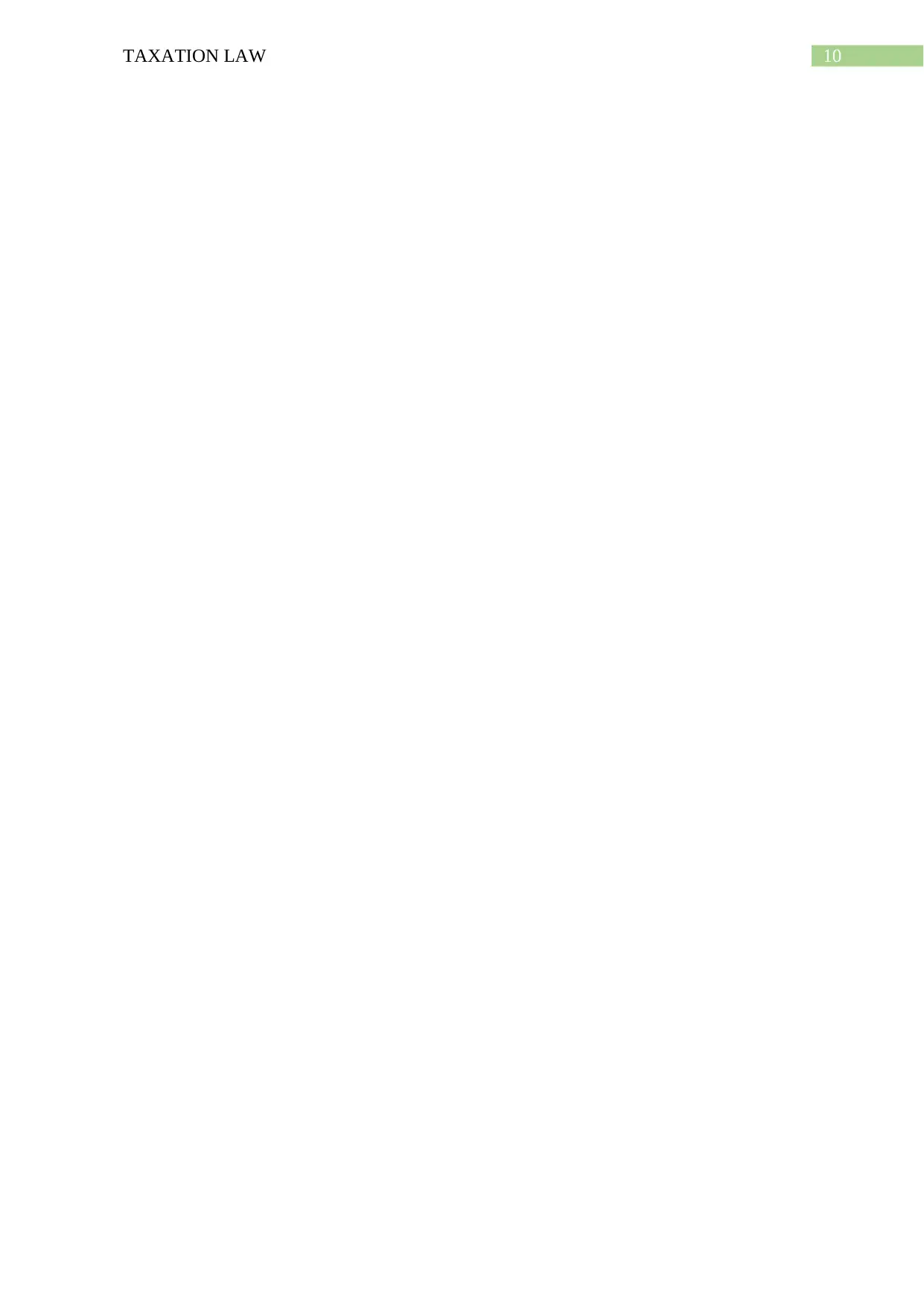
10TAXATION LAW
1 out of 11
Related Documents
Your All-in-One AI-Powered Toolkit for Academic Success.
+13062052269
info@desklib.com
Available 24*7 on WhatsApp / Email
![[object Object]](/_next/static/media/star-bottom.7253800d.svg)
Unlock your academic potential
Copyright © 2020–2025 A2Z Services. All Rights Reserved. Developed and managed by ZUCOL.





